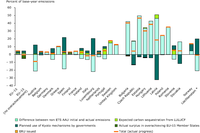
-

The average non‑ETS target corresponds to the average annual permissible in the sectors not covered by the EU ETS, calculated as the initial EU‑15 assigned amount minus the amount of allowances to be allocated under the EU ETS over the full commitment period. Permissible emissions can be calculated to take into account the use of carbon sinks and flexible mechanisms, which will increase the EU‑15 assigned amount. Excluding the overdelivery projected by Member States results in lowering permissible emissions.

-

-

-

-

A positive sign indicates that verified emissions (2008, 2009, 2010 and 2008/2010 average) were higher than available allowances (i.e. the EU ETS helps the Member State to reach its Kyoto target). A negative sign indicates that verified emissions were lower than available allowances (i.e. the EU ETS does not help the Member State to reach its Kyoto target).

The 'change in scope/coverage' concerns the correction from 2005–2007 to 2008–2012. The large corrections for 2005 and 2006 are related to Bulgaria and Romania, which entered the scheme in 2007 only.

-

The X-axis (0 % line) corresponds to the achievement of the EU-15 reduction target under the Kyoto Protocol (– 8 % compared to base-year emissions).
Positive values correspond to contributions to the achievement of the EU-15 Kyoto target, while negative values represent shortfalls.
The difference between target and GHG emissions concerns the sectors not covered by the EU ETS, which represent the right emissions and target to consider for the assessment of actual progress towards Kyoto targets.

The assessment is based on average 2008–2009 emissions and the planned use of flexible mechanisms as well as the expected effect of LULUCF activities. For each country, the top bar represents the gap between domestic emissions and the Kyoto target, while the bar below includes the planned effect of Kyoto mechanisms and carbon sinks. A positive value indicates a country for which average 2008 and 2009 non-ETS emissions were lower than the annual target. Based on the actual Swiss emissions for 2008 and 2009 and projections for the remaining years of the first commitment period, the Swiss government decided on 10 June 2011 to increase its use of flexible mechanisms to meet the Kyoto target.

The gap refers to the average 2008–2009 non-ETS emissions because no approximated 2010 GHG emissions are available.

A positive sign signifies a favourable contribution towards target achievement.

Positive values indicate net acquisition of Kyoto units while negative values indicate net sales.
The actual use of Kyoto mechanisms is based on the delivery of units according to the SEF table. Countries might have acquired more units than are recorded in the SEF tables, e.g. due to delivery dates later in the commitment period.
For the United Kingdom, SEF tables include the overseas territories and the crown dependencies of the United Kingdom. For the purposes of the implementation of Article 4 of the KP and as they are not part of the EC, the overseas territories and the crown dependencies of the United Kingdom were excluded from the initial assigned amount of the United Kingdom under the EC. In consequence, the trade of AAUs is slightly overestimated for the United Kingdom, as SEF tables for the geographical coverage of the United Kingdom under the EC only are not available.
For Denmark, Greenland is included in the SEF tables. For the purposes of the implementation of Article 4 of the KP and as Greenland is not part of the EC, Greenland was excluded from the initial assigned amount of Denmark under the EC. In consequence, the trade of AAUs is slightly overestimated for Denmark, as SEF tables for the geographical coverage of Denmark under the EC only are not available.
In Switzerland, the government decided to increase the use of flexible mechanisms compared to the current figure in order to achieve the Kyoto target.

A positive value indicates that the country has/expects net removals from LULUCF activities, taking into account the caps for forest management. It does not necessarily mean that the country intends to actually use RMUs to achieve its Kyoto commitment. The estimate of the actual effects of LULUCF activities might change in future years if better data becomes available.

A positive value indicates that average 2008–2010 emissions in the non-ETS sectors were lower than the average annual target, taking into account the effect of allowances attributed to the EU ETS and without use of carbon sinks and Kyoto mechanisms.

-

Sources of uranium delivered to EU-27 utilities in 2008

Net imports of all fossil fuels and CO2 emissions in EU-27 by fuel and origin of the fuel, 2008

EU27 Member State primary production of natural gas, oil and solid fuels as a % of total Gross Inland Energy Consumption, 2008
Document Actions
Share with others